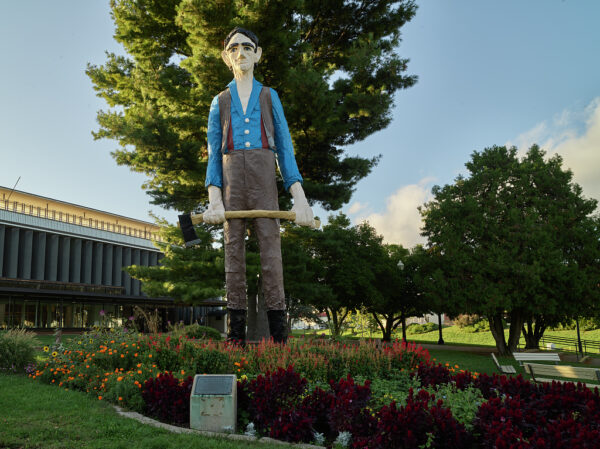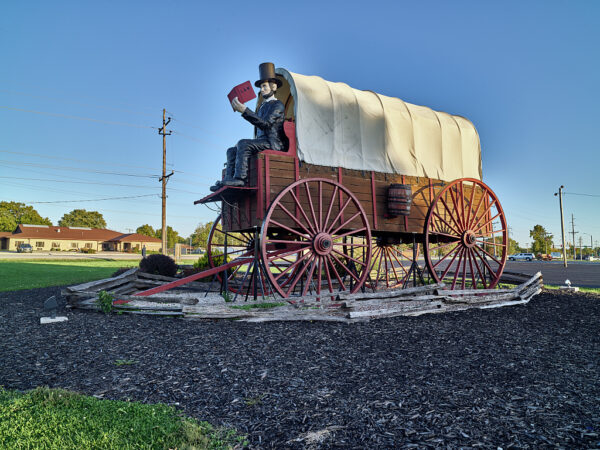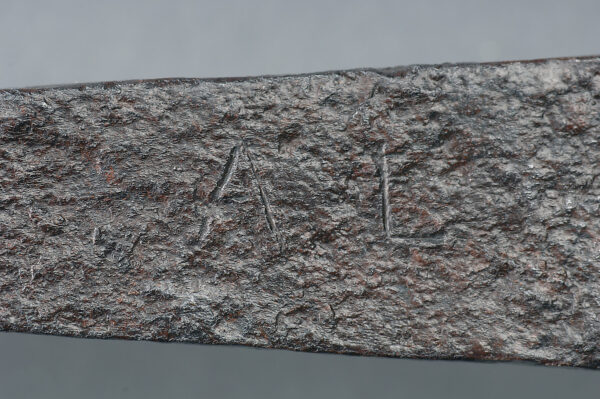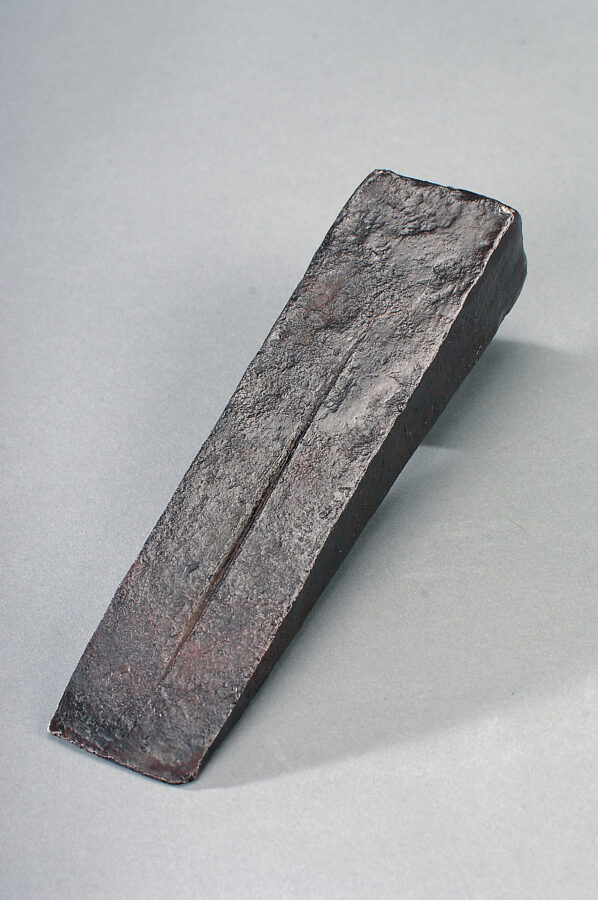The Wedge of Abraham Lincoln, the Railsplitter
We Americans admire people from humble beginnings who achieve success in fields such as business or politics or entertainment. Andrew Jackson, James K. Polk, Millard Fillmore, James Buchanan, Abraham Lincoln, Andrew Johnson, and James Garfield were all born in log cabins. After years of working hard, they reached the highest office in the land. Stories of ascending from humble beginnings to prominence have helped candidates win elections. Candidates from not-so-humble beginnings have sometimes found their beginnings detrimental to their campaigns. When William Henry Harrison, who had been born into wealth on the Berkeley Plantation in Virginia, ran for president, Whigs made up humble stories to help him get elected.
In May 1860, Republicans in Chicago met to select a candidate for the 1860 presidential election. Republicans who supported Abraham Lincoln staged a demonstration of support in the hall where they were meeting. They arranged for Lincoln’s cousin John Hanks to walk in carrying two fence rails that he and Lincoln had split decades earlier. Hanging from the rails was a banner that read: Abraham Lincoln the Rail Candidate for President in 1860.
Lincoln gained the campaign nickname of “The Railsplitter.” John Hanks gathered additional fence rails. He sold pieces of them to Lincoln supporters, who carried them in parades and placed them as decorations at various campaign headquarters.
Thinking that some of you might not have seen many or any split rail fences, I remembered seeing some when we visited Shiloh National Military Park last January. The park includes Shiloh Indian Mounds National Historic Landmark. I took this photo of Ray beside a split rail fence from the top of one of those mounds.

The Library of Congress has the following images depicting Lincoln as a railsplitter. This 30-foot-tall statue sits on the Illinois State Fairgrounds in Springfield, Illinois. Springfield native Cal W. Rinnus created it in 1968.

The Railsplitter by Carl W. Rinnus.
Photo by Carol M. Highsmith. Courtesy Library of Congress.
Lincoln practiced law at various courts in Illinois, including Lincoln, Illinois. In the 1850s, steam trains needed to stop for water every 30 minutes. When plans were made to construct a railroad between Springfield and Bloomington, Illinois, businessmen decided to create a town halfway between the two towns. They formed the Town Site Company. On August 24, 1853, they met with lawyer Abraham Lincoln at his law office. It was soon announced that the town would be named Lincoln. It was the first town named for Abraham Lincoln before he became president.

Railsplitter Covered Wagon in Lincoln, Illinois
Photo by Carol M. Highsmith. Courtesy Library of Congress.
This statue of Lincoln the Railsplitter stands in Garfield Park in Chicago, Illinois. Its sculptor was Irish immigrant Charles J. Mulligan. As a teenager, Mulligan worked as a stonecutter and attended art classes at night. He later studied art at the School of the Art Institute of Chicago and at the École des Beaux-Arts in Paris. He later returned to Chicago, became a teacher at the Art Institute, and began to receive commissions to create sculptures.

Lincoln the Railsplitter at Garfield Park in Chicago, Illinois.
Courtesy Library of Congress.
While searching for images of Lincoln the Railsplitter, I found one that artist Norman Rockwell painted in 1964. It is now in the collection of The Butler Institute of American Art in Youngstown, Ohio. It is not in the public domain to my knowledge, so I can’t paste an image here, but I encourage you to look at the beautiful Lincoln the Railsplitter painting on the Butler Institute’s website. It takes a few seconds to load but is worth the wait
The impetus to write this post first came while I was looking for an image of a blacksmith for my “Worthy Goals for Every Child” post. I came across the following image in the collection of the Smithsonian Institution. Its title on the Smithsonian image site is Lincoln’s Wedge .
Lincoln’s Wedge. Courtesy of the Smithsonian Institution. Gift of Henry W. Allen, 1920.
On one side of the wedge are the initials, “AL.”

Lincoln’s Wedge. Courtesy of the Smithsonian Institution. Gift of Henry W. Allen, 1920.
I was curious, so I read the description. This iron wedge belonged to Abraham Lincoln while he was living in New Salem, Illinois.
Lincoln first visited New Salem in 1831 when he was 22 years old. He and some companions were floating down the Sangamon River on a flatboat on their way to New Orleans. When the flatboat got stranded on a milldam, townspeople watched as Lincoln took charge and figured out a way to dislodge the boat. Local store owner Denton Offutt was impressed with how Lincoln handled the situation and offered him a job as a clerk in his store, which was not yet open. Lincoln continued to New Orleans and then returned to New Salem.
Lincoln did a variety of odd jobs while living in New Salem, in addition to working for Offutt. He also ran for a seat in the Illinois legislature, but lost the election. However, 277 of the 300 residents of New Salem voted for him. In 1833 he became New Salem’s postmaster. He served the local people kindly. When he knew someone was waiting for an important letter, he delivered it personally, even if he had to walk several miles to do so. While working as postmaster, he also did odd jobs, such as helping at the local grain mill, helping to harvest farmers’ crops, and splitting fence rails. He also began an earnest study of the law. To do so, he traveled 20 miles to the state capital of Springfield to borrow books from lawyer John T. Stuart. Lincoln received a license to practice law in 1836 and was admitted to the bar by the Illinois Supreme Court in 1837.
On April 15, 1837, Lincoln borrowed a horse, put all his belongings in two saddlebags, and moved to Springfield. No longer needing his railsplitting wedge, he gave it to his friend Mentor Graham. Workers discovered the wedge in 1885, while renovating a house in New Salem, which had once belonged to Graham.
A New Salem neighbor named John Spears remembered a story about the wedge. He said that Lincoln went to a blacksmith shop one day to get him to cut AL into the wedge. The blacksmith told Lincoln that he was no scholar. Lincoln borrowed the necessary tools and did it himself.
We all want our children to live responsible adult lives. There are many ways to live a responsible life, but all of those responsible adult lives involve working hard to take care of ourselves and our families while giving generously to other people.
Lincoln’s early life is certainly a good example of working hard. Every time you are patient and kind while insisting that your child finish a task you have assigned, you help him or her to learn the value of working hard and the contentment that comes from a job well done.
You yourselves know that these hands
ministered to my own needs and to the men who were with me.
In everything I showed you that
by working hard in this manner you must help the weak
and remember the words of the Lord Jesus, that He Himself said,
“It is more blessed to give than to receive.”
Acts 20:34-35
Norman Rockwell’s painting shows Lincoln holding an ax in one hand and reading a book he holds with his other hand. About his painting of Lincoln, Norman Rockwell wrote: “I hope this painting might inspire the youth of this land to appreciate this man who believed so much in the power of education.” In addition to teaching our children to work hard and live responsible adult lives, we also have the privilege of teaching them to live Christian lives which are devoted to God.
The fear of the Lord is the beginning of knowledge;
Fools despise wisdom and instruction.
Proverbs 1:7


